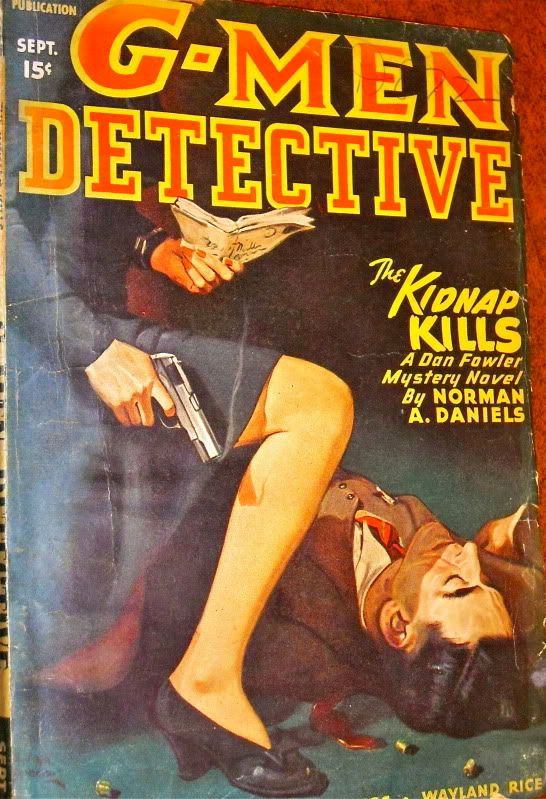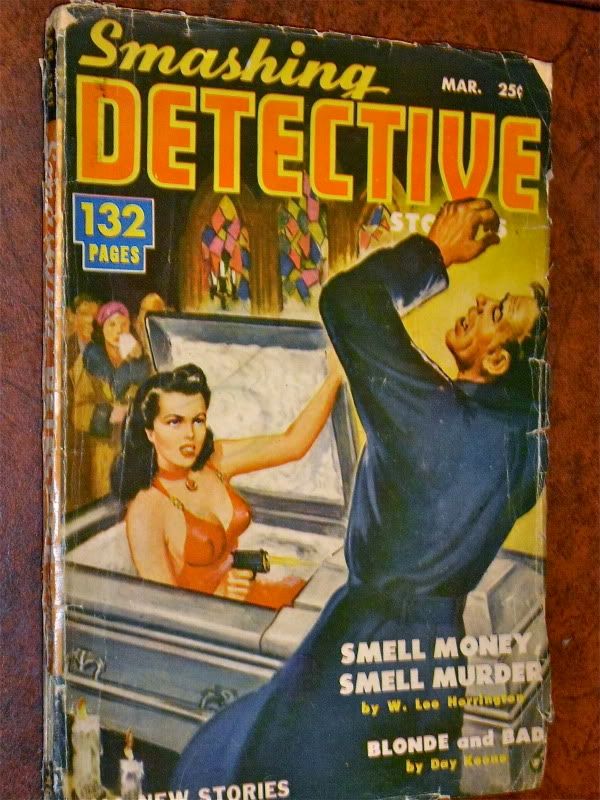
A few weeks ago I found myself at a book shop in the Tenderloin, sifting through stacks of old pulp magazines. I was scouring the shelves for a vintage copy of Weird Tales, preferably with an HP Lovecraft story, and having no luck whatsoever. Spotting a set of archival drawers, I decided to delve into them, and was soon up to my elbows in paper dust from copies of Doc Savage and old Conan comics. When I pulled out the sixth drawer and waved away the cloud of dust particles, I saw them-- a stock of vintage Detective magazines.
I love old detective pulps. Yes, the stories in them are mostly awful if you're not reading Chandler or the like, and the bad quality of the paper means it's almost impossible to keep them in good condition as a collectable (the name "pulps" actually came from the rough, wood-pulp paper they were printed on) but detective pulps have one thing about them that's always incredible: the cover art.
See, back in the days when pulp fiction magazines were big, there were literally a dozen of them lined up on the newsstand. The authors themselves weren't usually enough of a draw to make a young boy or a bored industrial worker pick one mag over another, so the publishers wisely made it their focus to have the most wicked-cool cover art on the rack. The preferred themes for these covers were murder, pin-up girls, and a surprising twist in the same picture, a combination that proved endlessly fruitful in the artist's imaginations- it eventually reached a point when authors were asked to depict the covers, rather than the other way around. As the art developed, film noir made its mark on the covers, bringing its palette of shadows and blood to the print medium to create increasingly sensational images.
Eventually, as publishers tried to one-up each other with salacious and action-packed covers, the art became so over-the-top that it shaded into self-parody. For example, one mens magazine in the early 60's depicted Fidel Castro holding a bikini-clad girl at knifepoint while a musclebound CIA agent rushed to her rescue. As you'll see, there's some serious "found comedy" waiting on the covers of the pulps below.
Overcooked or not, pulp art is fantastic at visual storytelling. Each pulp cover is itself a self-contained story, a little violent tableaux that whets the appetite and hooks the viewer with unanswered questions. Silly as they are, it's almost impossible to look at one and not have a narrative leap to mind.
These three I bought were my favorites, think of them as spark plugs for the imagination:

Famous Detective Stories, February 1951, Featuring: Trigger-Happy Honey, and The Chortling Corpse
Believe it or not, scenes like the above that show the hero "ambushing" a goon sneaking up on him or her are common in pulp detective magazines. Of course, the hero's ambush plans are often so overly-elaborate that they're just as absurd as they are exciting.
Let's consider this: obviously our hero is a hard-boiled detective of some sort. Obviously he's been roughed up by a street hood or a gangster to make him drop a case- he managed to survive, but now he's in a wheelchair, broken arm in a sling, getting 24-hour bedside care from a nurse that looks suspiciously like Marilyn Monroe. He knew that the bastards were coming to finish the job, and somehow he managed to convince Nurse Monroe to wrap his broken right arm in plaster while still gripping his forty-five.
Then he waited.
I love everything about this cover. The horror on the nurse's face, the firing detective who looks like he's cursing the goon as he kills him, and especially the enormous muzzle flash coming out of the cast. Hell, with the size of that cast, he could have anything under there- a shotgun, a Tommy gun, even a Mega Man cannon. The fact that the hardcase detective has a blanket over his knees like a Southern granny is just icing on the cake.
Man I hope this scene is in the actual story.
Oh, and how about The Chortling Corpse as a title, huh?

G-Men Detective, September 1947, Featuring: The Kidnap Kills
The cover above is from one of a series of "G-Men" pulps that were popular during the 40's and 50's, which centered around FBI agents being good, flag-waving, upright Americans while outwitting bank robbers, smugglers, and people who believed that workers should control their own means of production.
This is a pretty standard pulp cover, if a highly intriguing one. Note how it establishes a story hook right off the bat: a man has been shot, and a woman was seen taking a packet of documents off his body, but she can't be identified. Who is this mysterious woman with excellent taste in shoes? What are these missing documents, and what makes them worth killing for? Who is this man? Is he an FBI agent? A consular officer? My God, if he's a consular officer, could those be diplomatic dispatches?! Secret codes?! Could this be the Russkie's first move?! Has the balloon finally gone up, leaving Berlin on the very brink of being ravaged by the Soviet horde?! Can Hoover's intrepid band of agents thwart the Red Menace in time?! Oh dear God I have to read this story!
This is a classic example of visual storytelling. Admit it: you want to read what's behind this cover. This single illustration suggests murder, intrigue, mystery, and a femme fatale, and all in the space of a single sheet of office paper.

Smashing Detective Stories, March 1951, Featuring: Smell Money, Smell Murder and Blonde and Bad
This is hands down my favorite of the bunch for its sheer ridiculousness. Here we see another "ambush" picture, but this time the hero isn't pretending to be hurt, she's pretending to be dead. That's some dedication, right there. What's even more intriguing about this picture is the fact that the victim doesn't seem to be carrying a gun at all- so what exactly is happening here? Did he try and kill her, and she's taking revenge on her would-be murderer?
Here's my stab at it: she was a too-trusting dame with a good heart and a bad taste in fellas. Against her better judgement, she took out a massive loan from the local loan shark to finance a business deal for her no-good boyfriend, who to no one's surprise, split for Atlantic City with a cocktail waitress and the suitcase full of cash. Suddenly she's being chased by a mob shylock with a monographed pair of brass knucks and an unforgiving demeanor. At the end of her rope, she gets an idea: she fakes her death and arranges an open-casket funeral, then waits for her weepy, regretful, no-good dirtbag ex-squeeze to come by and pay his final respects, then... Surprise, Darling!
But that still doesn't explain why she chose to be eulogized while wearing the sluttiest cocktail dress known to science. Honestly, the thing I love most about this cover is how ham-handedly it smashes together the themes of sex and death. Consider it: not only is a scantily-dressed fantasy pinup killing a man, she's doing so from inside a casket. Even before you factor in the irony that the pair have switched places-- the "dead" woman coming to life and the living mourner being killed--the picture already has a lot of accidental subtext to process. The warm and inviting look of the stained glass windows in the background make the whole thing even more surreal, like Easter Sunday in the Village of the Damned. Also notice the lady in the background sniffing into her handkerchief... I mean most funerals are awkward, but really.
A creative writing professor once told me that every great novel could be boiled down to sex and death. Based on this evidence, I postulate that Smell Money, Smell Murder, sold eighty-six trillion copies and won every Pulitzer for literature between 1951 and 1964.
What do you guys think? Do any of the covers above suggest an alternate narrative to you? Tell me in the comments!
No comments:
Post a Comment